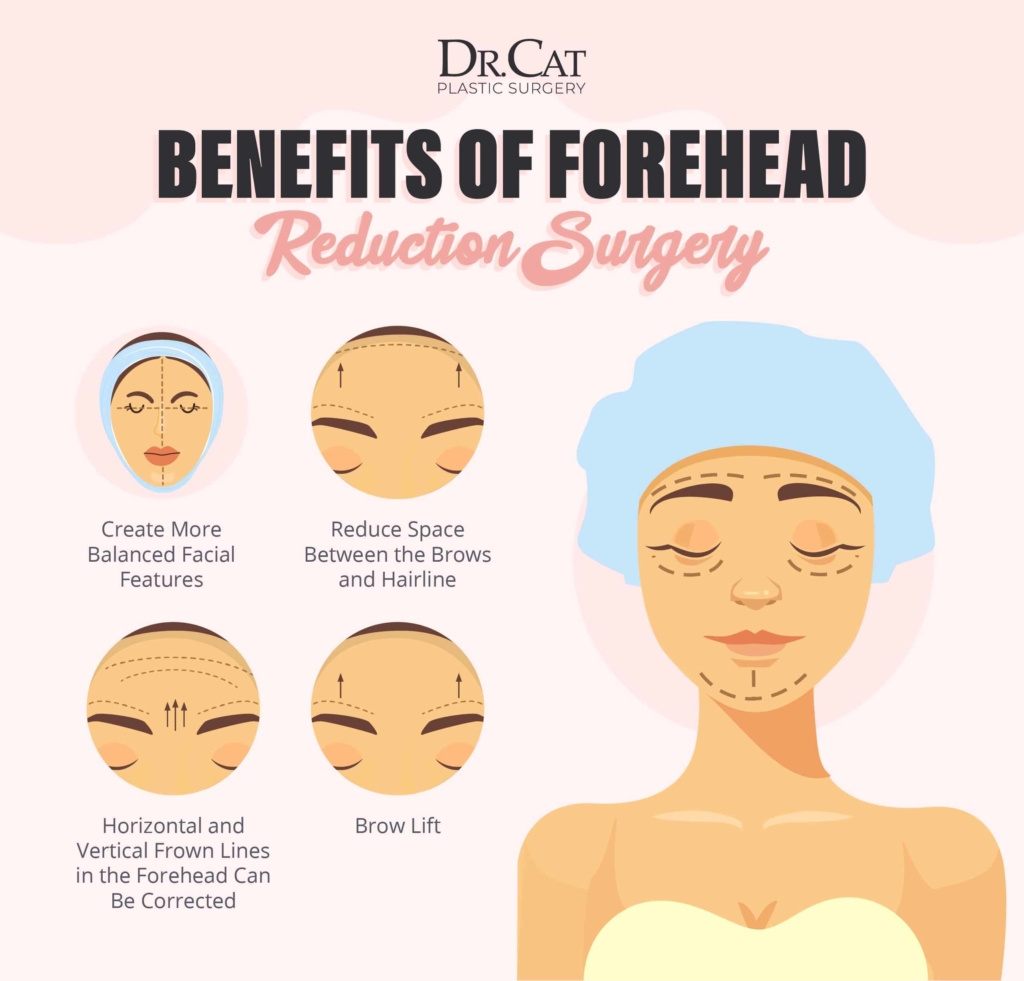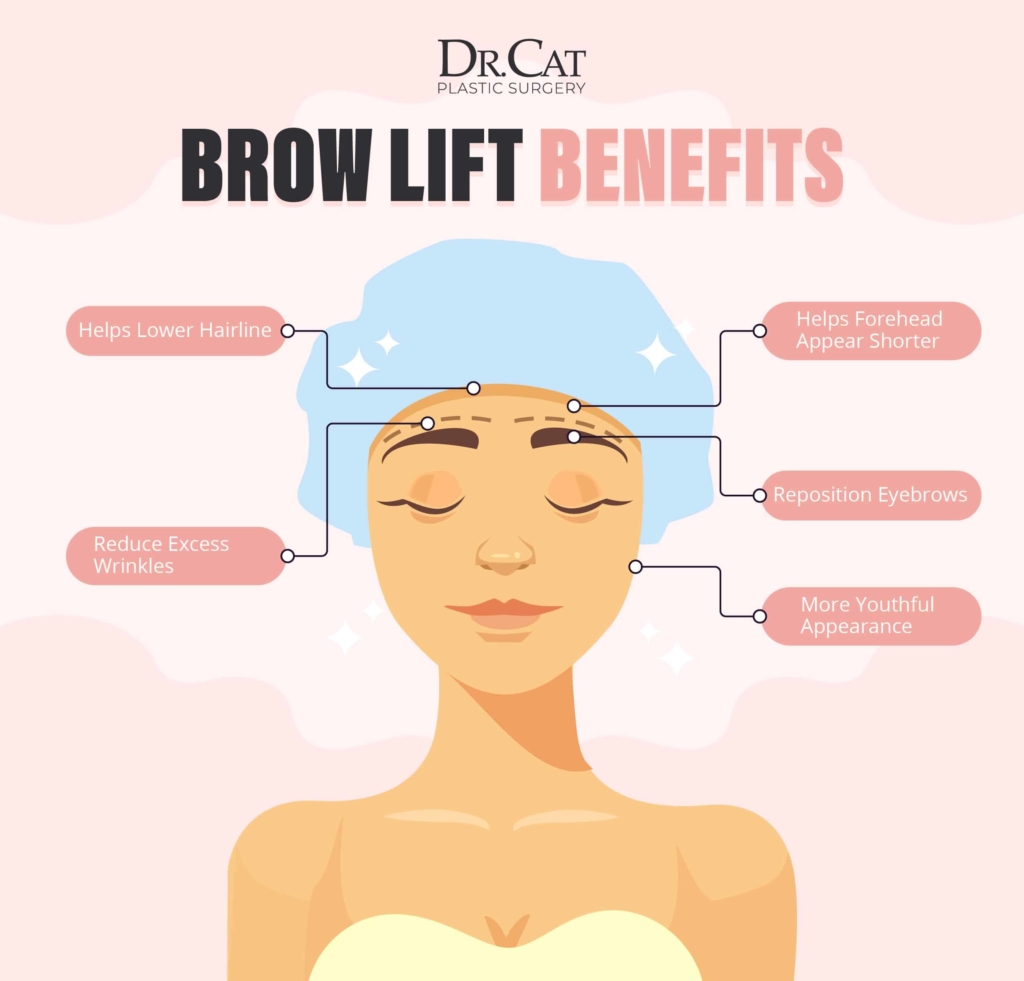Having a large forehead or a high hairline can cause someone to feel self-conscious. This genetic condition affects both men and women, but luckily there are solutions for hairline concerns. One solution to consider is to talk to a surgeon about a forehead reduction surgery, also known as a hairline lowering surgery.
The term “forehead reduction surgery” refers to a group of cosmetic procedures that shortens the distance between the eyebrows and the hairline. Each patient is unique, so every person has a personalized treatment plan that might involve a brow lift and/or moving the hair-bearing portion of the scalp lower.
Benefits of Forehead Reduction Surgery
This cosmetic forehead surgery offers many benefits for patients who are worried about the growing gap between their hairline and eyebrows. When the forehead gets larger, it can cause imbalanced proportions on the face, which might affect a person’s self-esteem.
The goal of hairline lowering surgery is to create more balance in the facial features. With the proper technique and an experienced surgery, the result is a better proportion in the face.
Many times, the higher hairline is happening because of hair loss. So, people often assume that the ideal solution to correct this problem is to have hair restoration surgery. While hair restoration is one option, forehead reduction surgery is an alternative that delivers faster and better results. Hair transplants don’t create as much hair density in the target area compared to the results that are possible with forehead surgery.
Not only does forehead reduction surgery reduce the space between the brows and hairline, but this treatment can also help smooth the furrows and forehead lines at the same time. Both horizontal and vertical frown lines in the forehead can be corrected when the hairline surgery is paired with a brow lift.
How Does Forehead Reduction Surgery Work?

The procedure only takes a few hours, and you will be under anesthesia during this time. Before the forehead surgery begins, the surgeon will mark the forehead to plan the new hairline by drawing on your forehead and scalp.
Next, the surgeon creates the incision, then carefully loosens the tissues so the hair-bearing scalp can be moved. Then, the skin is repositioned forward by as much as 1 – 3 centimeters, depending on the patient’s unique needs. Additionally, excess skin is removed before the incision is closed. Finally, a minimum of two layers of surgical stitches are required to secure the hairline and close the incision.
Sometimes, additional steps will be necessary for this forehead reduction surgery. For example, if the scalp doesn’t have enough elasticity to lower the ideal amount, then a tissue expander can be placed under the scalp. This expander stays in place for about six weeks and slowly stretches the skin over time. Then, a follow-up surgery is scheduled so the surgeon can remove the expander and finish the forehead reduction surgery.
What to Expect: Recovery After Forehead Reduction Surgery
Every person has a different experience, and the recovery depends on the specific type of forehead surgery you have as well as your unique healing time. Most people who choose this cosmetic treatment need about a week for recovery. Then they are able to start their normal daily activities again. You’ll need to plan recovery time, so the bruising and swelling start to go down.
In most situations, patients can go home without wearing surgical dressing the day after the surgery. However, when returning to work or school after a week of recovery, wearing a headband or hat is common to cover the healing incision. Sometimes, it’s possible to brush the hair forward to hide these sutures.
There are a few things the surgeon will suggest to support your recovery:
- Pain Medication: Most patients take prescription pain medication for the first few days. If additional pain relief is needed, then over-the-counter pain medications can be used after you are finished with the prescription.
- Sleeping Position: You’ll want to keep your head elevated, even while sleeping. Propping the head up on several pillows can reduce swelling and bruising. The most comfortable solution is an incline position for the upper half of the body.
- Cleaning the Incision: Following the doctor’s instructions for cleaning the incision will help reduce the infection risk. You’ll also want to watch for potential signs of infection and talk to your surgeon immediately if you suspect an issue.
Even though you can return to most normal activities after a week, it’s a good idea to avoid strenuous activities until the incision has healed. It takes up to 3 months for the forehead reduction surgery scar to fade, so you can expect to cover it or adjust your hairstyling during this time.
Some patients have temporary numbness on their forehead reduction surgery scar that lasts for 4 – 6 months. However, the numbness usually subsides within a few months because the nerves start to grow back.
Post-Surgery Checkup with Your Cosmetic Surgeon
Plan on visiting with your surgeon a few times after the surgery is complete. For example, the sutures usually need to be removed about 1 – 2 weeks after the surgery.
Additionally, patients will need to come to the office for a post-operative checkup 2 – 4 weeks after the surgery. In the rare case that complications arise, multiple post-surgery appointments might be required. Your surgeon will provide personalized recommendations to ensure you have the care and treatments that you need during recovery.
Are There Risks from Hairline Reduction Surgery?
As with any other type of surgery, there are always potential risks or complications that can occur. But when working with a reputable, experienced surgeon, you can rest assured knowing these risks are minimized.
This surgery is considered safe for most people. However, potential side effects might include scarring, bleeding, numbness, swelling, bruising, asymmetry, discomfort, hair loss (temporary or permanent), or infection. Following post-surgery recovery instructions can minimize these side effects and optimize the overall outcome of the treatment.
Other potential side effects can occur from general anesthesia or a reaction/allergy to local anesthesia.
After surgery, most patients feel the discomfort was worth it because of the noticeable results that are achieved. In addition, this cosmetic procedure has a high level of satisfaction.
How Noticeable Is the Scar After Hairline Reduction Surgery?
There will be a scar along your hairline, and it will be noticeable in the first few months after surgery. Over time, the scar will start to fade and blend in with the hairline more effectively.
About 6 months after the surgery, you can expect the scar to be faded as much as possible. Usually, this scar is easy to hide under your hair, so there isn’t a concern about other people seeing the scar.
Also, hair follicles are located next to the scar and underneath the scar. As these hairs start to grow, they help to hide the scar. Some people choose hair grafting later on if they want to cover up the scar more.
Is Forehead Reduction Surgery Right for You?
This hairline lowering surgery (and often a brow lift) is a great solution for anyone looking to create a more balanced, youthful appearance. However, if you feel self-conscious about the size and shape of your forehead, then it might be time to talk to a cosmetic surgeon to learn more about your options.
This surgery is most often performed on women who don’t have a family history of hair loss. Men can also schedule the treatment. It’s recommended only for people without a strong family history of hair loss because the results will only be temporary if the patient continues losing hair after the surgery.
Patients who are an ideal fit for forehead reduction surgery are people who meet these guidelines:
- High forehead
- Good elasticity in the scalp
- No hair thinning or hair loss
The surgery is an effective way to change facial proportions and can offer lasting results and improved confidence. The ideal candidates are people who notice the signs of aging and want to reduce the appearance of wrinkles and fine lines while also changing the position of the hairline.
Hairline lowering surgery is also an option for transgender patients transitioning from male to female. Lowering the hairline can create a more feminine appearance, and this treatment is often paired with other cosmetic surgeries such as a brow bone reduction.
How to Lower Hairline for Long-Term Results
The good news is that forehead reduction surgery can last a lifetime. So when you choose a good surgeon, the results can be indefinite.
Because these results are long-lasting, hairline lowering surgery is an excellent investment. You go through the treatment right now, then enjoy the benefits for the rest of your life.
Continued hair loss can have a negative impact on the results of this surgery. So, if you are experiencing hair loss, you might talk to your cosmetic surgeon about other options to minimize the forehead size. Most surgeons recommend against forehead reduction surgery when hair loss continues to progress since the additional loss of hair will eventually result in a bare scar and higher forehead once again.
Why Pair a Brow Lift with Hairline Lowering Surgery
Not only can this cosmetic treatment help by lowering the hairline, but it’s also possible to reduce excessive wrinkles simultaneously when paired with a brow lift. In addition, this treatment can reposition the eyebrows, so they are elevated to create better balance and symmetry on the face.
During a brow lift, the surgeon shifts the skin and manipulates the muscles in the eyebrow area to reposition the brows higher above the eyes. When a brow lift is done right, it can make the forehead appear shorter.
Another benefit of a brow lift is raising brows that are sagging too low and causing a hood over the upper eyelids. Lifting the eyebrows not only creates a more youthful appearance but can also make the eyes look brighter and more vibrant. In addition, when the eyebrows are in a more alert position, it improves the overall aesthetics of the face.
Other possible treatments that might be paired with a hairline lowering surgery and brow lift include an eyelid lift or facelift. Additionally, some patients choose Botox after healing from the surgery to maintain the results. It can also be beneficial to use skin resurfacing techniques to improve the overall complexion.
Preparing for Hairline Lowering Surgery
Certain lifestyle factors increase the likelihood of complications. For example, smoking boosts the risk of problems with wound healing, so the surgeon will likely recommend that you stop smoking before the surgery. Ideally, a patient hasn’t been smoking for 2 – 12 months before the forehead reduction surgery (or any other type of surgery) is completed.
Other recommendations include the avoidance of certain medications that can increase the risk of excessive bleeding, such as specific prescriptions, aspirin, alcohol, and anti-inflammatories. Your doctor will discuss your medications and offer personalized recommendations for adjusting the dosages and use before surgery.
How Much Is Forehead Reduction Surgery?
Since this surgery is categorized as cosmetic, insurance providers don’t pay for the associated costs. So, you’ll need to pay the bill on your own or look for a financing plan that allows you to make monthly payments.
The final cost varies for each patient because it depends on the specific treatments that are completed as part of the overall procedure. For example, the price is higher to pay for both hairline lowering surgery and a brow lift compared to one of these treatments as a standalone treatment.
Cost factors that can influence the amount you pay include:
- Surgical facility or hospital costs
- Anesthesia fees
- Surgeon’s fee
- Medical testing
- Medication and prescriptions
Additionally, the price varies depending on the surgeon that you choose. But don’t make the mistake of selecting the cheapest surgeon you can find because you don’t want to sacrifice the quality of the results because you are trying to save a little money. Instead, focus on the value you receive and the reputation of the doctor you are working with.
In fact, some patients want to pay a little more to ensure they are working with the best surgeon available. Remember that this treatment is an investment that can boost your self-esteem for the rest of your life, so it’s worth the money to ensure you achieve the desired results.
When you meet with the surgeon for a consultation, ask: how much is forehead reduction surgery? You will receive a personalized estimate based on the extent of surgery planned for your unique preferences.
Personalized Plan for Cosmetic Surgery
Every person’s face is different, which is why there isn’t a one-size-fits-all solution for the surgery. Instead, Dr. Cat takes the time to complete a detailed facial evaluation, then offers a customized plan that helps each patient achieve the desired results. The goal is to ensure that the forehead matches the other facial features, including the eyes and face. Ultimately, you will have a natural, harmonious appearance when the surgery is complete.
Additionally, patients have unique preferences and goals. During the consultation, it’s important for the surgeon to understand the desired results. So, our team encourages you to bring different examples, such as pictures that show what you like (and what you don’t like). This in-depth conversation about your aesthetic preferences helps the surgeon design the ideal surgical plan to meet your needs.
During the consultation, it’s also important to consider your medical history and family history. A thorough examination is done to look at your anatomy and determine realistic goals and outcomes.
A variety of factors are considered when designing a personalized surgical plan, including age, emotional well-being, and the expectations for surgical results.
It’s important to have realistic goals about the outcome of this surgery. The results will be noticeable, and many people find that they look years younger after cosmetic surgery. At the same time, the goal is to maintain a natural appearance so that the surgeon will discuss realistic possibilities for the outcome of this treatment.
Learn More About Forehead Reduction Surgery and Other Cosmetic Treatments
The advances in the cosmetic industry have brought many options to the general public. If you want to feel more confident about your appearance, it might be a good time to talk to a knowledgeable plastic surgeon about your options. Not only can Dr. Cat share information about how to lower a hairline with a smaller forehead surgery, but you can also learn about a wide variety of other available cosmetic procedures.
If you are considering forehead reduction surgery, then we invite you to contact our office to schedule a consultation. There’s no doubt that your life can change from these cosmetic treatments.
Dr. Cat Begovic is a reputable plastic surgeon in the local area, providing personalized cosmetic treatments for people of all ages. Options include full mommy makeovers and non-invasive treatments, including ThermiSmooth.
Dr. Cat is proud to be a board-certified surgeon and has worked with many patients over the years. Her decades of experience bring top-notch results to everyone who walks through the door. Call today to learn about available treatments and book an appointment.


